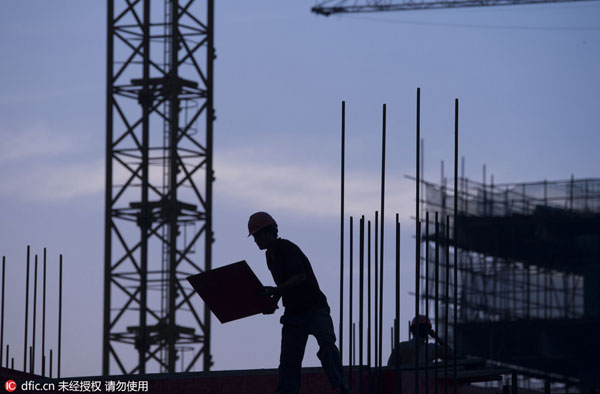Setting the economic growth tone for 2017
 |
|
Workers on a construction site in Nantong, East China's Jiangsu province, July 9, 2016. [Photo/IC] |
The Central Economic Work Conference, held in Beijing in mid-December, set the tone for economic development in 2017. This is the first time the conference upgraded "seeking progress while maintaining stability" to an unprecedentedly high level-from a methodology for economic work to an important principle for governance.
"Stability" is the theme and objective of this principle. And it means steady economic performance, "more proactive and effective" fiscal policy to serve the supply-side structural reform, "prudent and neutral" monetary policy, further cuts in taxes and administrative fees, appropriate level of money supply and credit size, and relatively stable interest and exchange rates.
"Progress" is reflected in the extension of the supply-side structural reform to agriculture, rejuvenation of the real economy and the creation of a long-term mechanism for the stable and healthy development of the property market. It means breakthroughs should be made in the reforms of such important sectors as State-owned enterprises, finance, taxation and elderly care services.
I believe China's economic growth rate in 2017 will be lower compared with 2016, probably between 6.5 percent and 6.6 percent, as the economy is yet to bottom out.
Policymakers have decided to continue cutting industrial overcapacity, reducing housing inventory and leverage levels, lowering corporate costs and improving weak economic links in 2017. And eliminating "zombie enterprises" is the key to cutting overcapacity. The country used to rely on administrative tools to cut overcapacity, but in the future, it must gradually adapt to the market and use legal approaches to do so while according priority to formulating and enforcing standards on environmental protection, energy consumption, safety and quality.
"Deleveraging" mainly means lowering the leverage levels of State-owned Enterprises, for which one of the important approaches is the debt-for-equity swap. Since this plan is aimed at better protecting the interests of creditors, strategic investors should be brought in to improve the enterprises' equity structure, governance and regeneration capability, and to stimulate and enhance their self-development capacity and innovative vigor.
The government has proposed a "proactive and effective" fiscal policy, using the term "effective" for the first time to define the fiscal policy. So the policy should be more targeted and should facilitate the supply-side structural reform, and focus on lowering corporate costs and improving weak economic links.
While emphasizing an increase in fiscal expenditure, we should pay more attention to how to attract and guide social capital into the fields that have a direct bearing on people's livelihoods, including public-private partnerships.
A prudent and neutral monetary policy is now in place. So the growth rate in broad money supply in 2017 will range between 11 percent and 13 percent. The economic work conference said the monetary policy should "adapt to the new changes in the methods of money supply", so it deserves special attention, because it means that against the backdrop of a depreciating yuan and capital outflows, the central bank will resort to cuts in reserve requirement ratios and open market operations as the main methods of money supply in 2017.
The US dollar index has already risen above 103, but it is unlikely that the yuan will continue to weaken against the dollar. Besides, a rising dollar could fluctuate, too. After being sworn in as United States president, Donald Trump is likely to adopt an expansionary fiscal policy and a contractionary monetary policy. As a result, the US may see a surge in both fiscal deficit and current account deficit, forcing the dollar to shed some of its value.
The fact that the document released after the economic conference says that "houses are built to be inhabited, not for speculation" makes the government's intention pretty clear. For the property sector, the government has called for the creation of basic institutional systems and long-term mechanisms that suit China's national conditions as well as comply with market rules.
Investment in the property market was expected to increase by about 6 percent in 2016, but the anticipated growth in 2017 is slightly lower, between 4 percent and 5 percent. The expected investment growth rate, however, is high enough to maintain some stability in the sector and prevent big fluctuations.
With the deepening of supply-side structural reform in the agriculture sector and a new type of urbanization, farmers' incomes will increase, which will make an increasing number of farmers financially capable of buying houses in towns and cities.
The author is deputy chief economist of the China Center for International Economic Exchanges.
Courtesy: chinausfocus.com
















